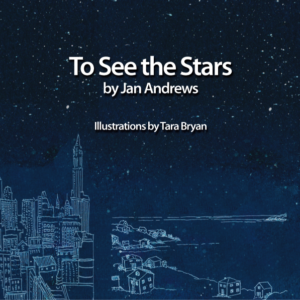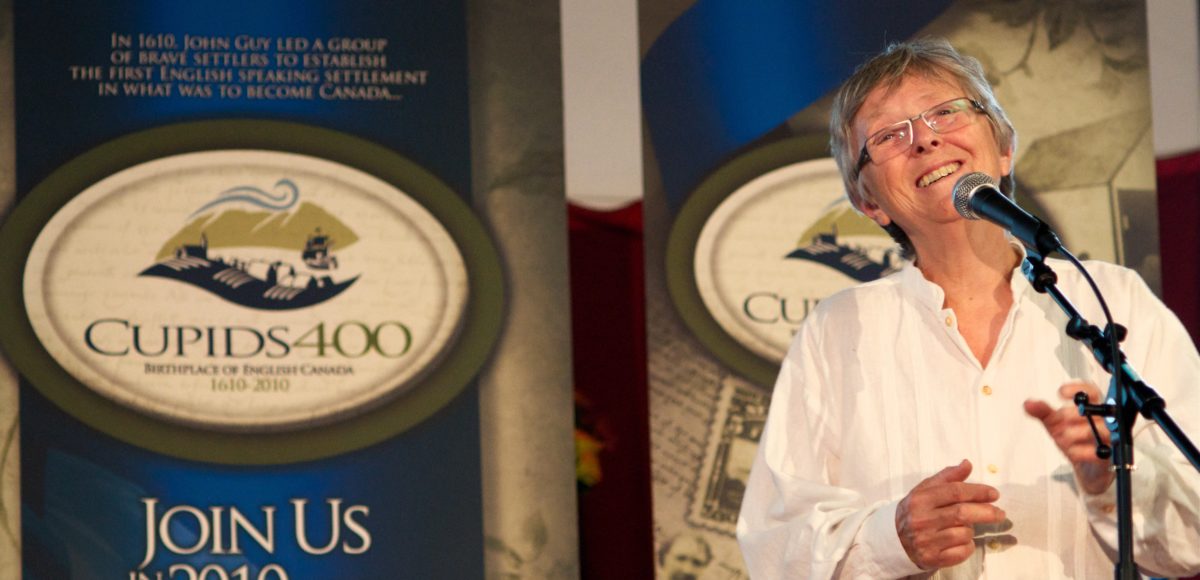This is a bittersweet story
It starts, in a way, some 20 years ago with the germ of an idea. That’s when Lanark County’s Jan Andrews, storyteller, author, arts administrator, activist, first thought of Edie Murphy and the book To See The Stars.
Edie stayed with Jan and she picked away at her story over time until it was finally almost finished in the fall of 2017. That was a sweet moment. It was a book she had really struggled with. And then Jan took a fatal tumble down a set of stairs.
That was a bitter time for Jennifer Cayley, Jan’s partner. But, even though she was mourning, Jennifer still had a job to do.
Part of that work happens this weekend at the Ottawa International Writers Festival when Jan’s final novel — and her career — will be celebrated in a special panel that also features local writers for young people Alan Cumyn and Tim Wynne-Jones.
To See The Stars tells Edie Murphy’s journey from her outport home in Newfoundland to St. John’s and then on to New York City. It discusses her life as a servant and later as a garment worker. Jan thought the book was really a collection of five short stories strung together by the presence of Edie, Cayley said. Whatever it is, the book has a wonderful, magical feel to it.

Jan was always busy on projects so it’s not surprising the book took awhile. But there’s another reason.
“She was an extremely careful writer, very slow. even at her fastest, she was very slow,” Cayley said.
She also battled with the book.
“It seemed like a collection of ideas and a collection of incidents to her” for a long time, before it started to coalesce.
The book starts, like several of Andrews’ works, in Newfoundland.
Jan ha d a great affinity for the province. Proof: the book is dedicated to a Newfoundlander named Jane Green and three of Jan’s four chapter books are set in the province.
“Jan was in St. John’s doing the research for the book in 9/11,” Cayley said. That was a time of bonding and Jane Green was the woman Jan was staying with.
“Jane was the mother of a friend of mine who had come to Newfoundland with her five daughters. Jan and Jane shared that same British background” enjoying the silly side of English humour and life.
“They loved one another and loved being together.”
“She had a strong affinity for Newfoundland. She loved the landscape.” And she loved the people. They reminded Jan of her English home and the working class family she came from. These are people who just get on with it, Cayley said, and do what they have to do no matter what else is happening.
So when a pregnant teenaged girl barges into Edie’s life in the throes of labour she deals with the situation.
“It’s really what all of her work is about,” Cayley said.
In fact, Newfoundland is the home base of the publisher of the book. Running the Goat Books and Broadsides is run by Marnie Parsons. The firm publishes mostly picture books by Newfoundland writers out of a little house in Tor Cove, south of St. John’s.
Parsons launched Andrews’ book in March along with a book by the actor and storyteller Andy Jones.
Cayley said Jan Andrews was a writer for young people, but she said she believes this book is a bit of a crossover. It talks about adult themes.
“For Jan, it was not that you are just managing. You have a responsibility to have a good life. It’s not just by chance you are happy. You have a good life with joy in it because you determine that’s what your responsibility is.”
But she could have fun too.
“Her first book Very Last First Time tells of an Inuit child who goes looking for mussels under the sea ice in winter. She drops her candle and is frightened. By time she gets back out the moon is up and she dances. Jan was saying there is dancing in life too.”
To See The Stars is also the story of a working class girl at a time when women were exploited in service of the rich or in places such as the garment factories in New York City.
“Jan’s mother finished school at 14 and went to work in a shoe shop in London where titled women treated her like dirt,” Cayley said.
So are there hints of Jan’s life in the book?
“Psychologically there are. Jan came from a working class background. She was the first person in her family to go to university.
“Her grandmother and her mother lived that life. There are certainly elements of her mother’s life. It’s Jan’s family story rather than her own narrative.
“I think any book has pieces of the author there.”
The novel does talk about the formation of the Garment Workers Union and the infamous Triangle fire, both famous and infamous events in the history of working class people. Andrews spent time in New York researching at the Tenement Museum.
Since that initial launch, there have been other events including one in Toronto.
On the eve of the writers festival event in Ottawa, Cayley recalls her thoughts when she faced Jan’s manuscript after her death.
She steeled herself and did some of the final edits on the book.
“As I have said to many people, I thought to myself if there was anything in the world that would bring Jan back, it would be the spectre of me editing her words.
“Jan and I started MASC together (in 1987). When we started it, I didn’t know anything. I couldn’t write a grant application. She spent several years teaching me how to do that stuff. She was always the person who would tell me my writing was inadequate.”
So Cayley feels that Jan was probably standing over her shoulder as she picked up her editing pencil.
“She was always a person who recognized when something had to be done.”
These days Cayley is reflecting.
“I feel glad the book is out. There is so much of her in it. Anyone who knows her, who picks up the book, they have to stop because they hear her voice in it so strongly. But it is terribly sad.”
She is also grateful to Marnie Parsons.
“I think another publisher might have dropped it when Jan died and Marnie was a delight.” And Cayley is particularly pleased with the whimsical illustrations by another Newfoundlander, Tara Bryan.
It’s had a write up in Quill & Quire and a good review in the Globe and Mail.
“Because it was published posthumously it can’t be nominated for awards but it is being celebrated” which pleases Cayley.
It’s also not the last book, she said. “There is a picture book that will be coming out in a year or so. I think it will be called I Remember. Ironically, Cayley said, that next book was started the same time as To See The Stars.
Alan Cumyn, who is a fellow Ottawa writer for young people, is looking forward to the event in which he’ll participate.
“I met her in the mid-90s through the Writers Union of Canada. We mostly connected at writing events over the years. It’s a small community in Ottawa and I’ve been to a number of her storytelling shows and around her books for a long time.
“I loved the book. I remember her talking about it at different stages. I think she really nailed voice of heroine. It has real emotional impact for a short novel and it sums up for me how much she cared about social issues and writers getting paid properly.”
In town: The Ottawa International Writers Festival is hosting a panel Seeing The Stars: Hope, Redemption and Resiliency featuring Alan Cumyn, Tim Wynne-Jones and Jennifer Cayley. The event is at 3 p.m. on May 5 at Christ Church Cathedral. Tickets and information: writersfestival.org.







